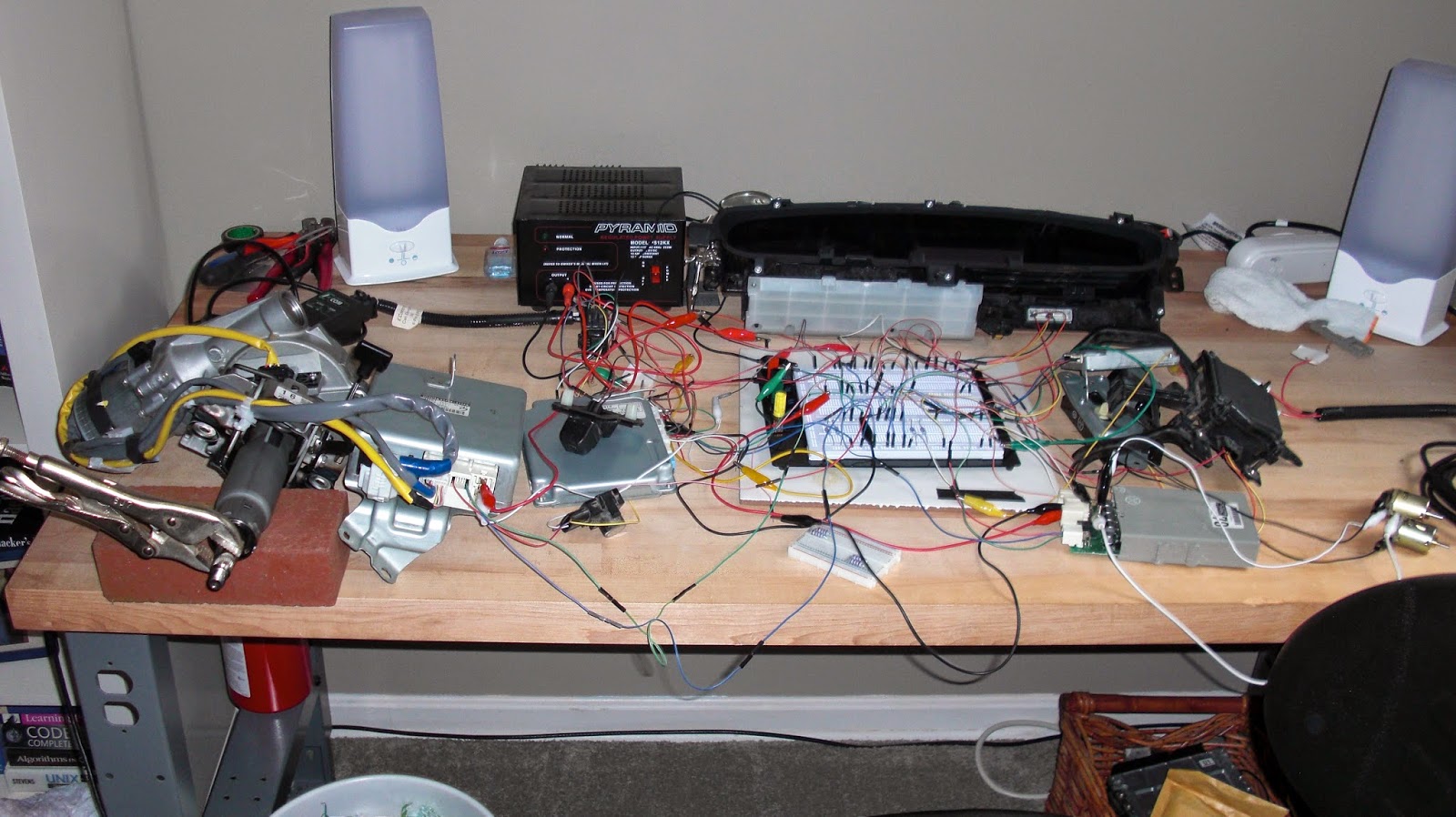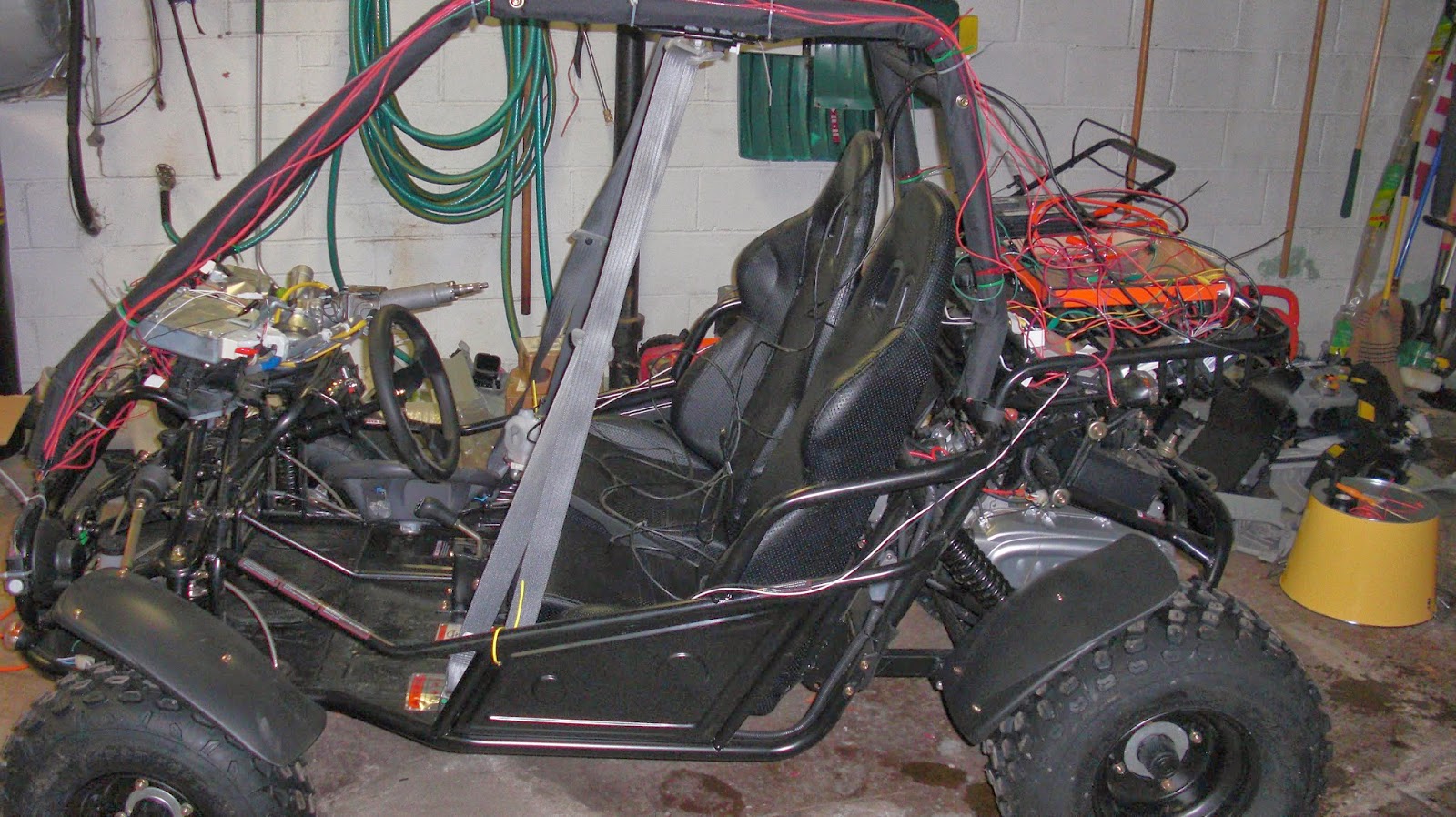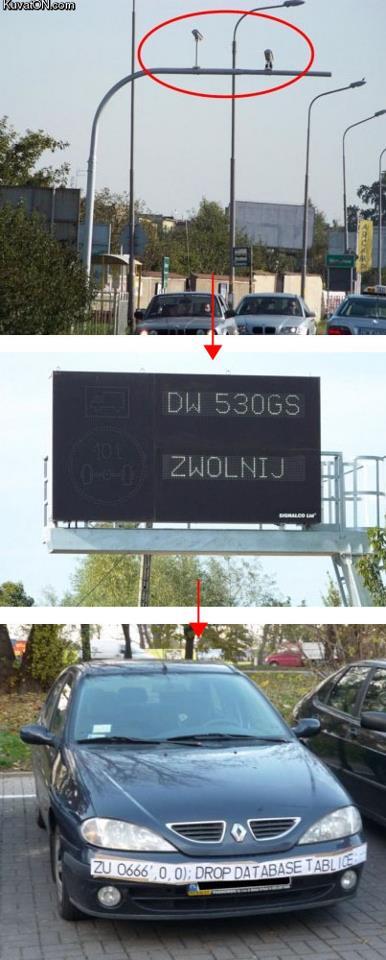Does everyone remember when those two handsome young gentlemen controlled automobiles with CAN message injection (https://www.youtube.com/watch?v=oqe6S6m73Zw)? I sure do. However, what if you don’t have the resources to purchase a car, pay for insurance, repairs to the car, and so on?
Fear not Internet!
Additionally, we provided a solution for a mobile testing platform (a go-cart) that can be fashioned with ECUs from a vehicle (or purchased on Ebay) for testing that requires locomotion, such as assisted braking and lane departure systems.
For those of you that want the gritty technical details, download this paper. As always, we’d love feedback and welcome any questions.
Hi Everyone,
As promised, Charlie and I are releasing all of our tools and data, along with our white paper. We hope that these items will help others get involved in automotive security research. The paper is pretty refined but the tools are a snapshot of what we had. There are probably some things that are deprecated or do not work, but things like ECOMCat and ecomcat_api should really be all you need to start with your projects. Thanks again for all the support!
Content: http://illmatics.com/content.zip
Hi Internet!
I wanted to put up a blog explaining what exactly we’ll be talking about in a bit more detail than was provided in the abstract. Our abstract was purposefully vague because we weren’t really sure what we were going to release at the time of submission, but obviously have a much more concrete set of items now.
Also we wanted to remind everyone that although we did not focus on remote attack vectors, intricate knowledge of a car’s internals / CAN network would be necessary after remotely compromising the vehicle for any amount of control (steering, braking, acceleration, etc).
Talking points
- We will briefly discuss the ISO / Protocol standards that our two automobiles used to communicate on the CAN bus, also providing a Python and C API that can be used to replicate our work. The API is pretty generic so it can easily be modified to work with other makes / models.
- The first type of CAN traffic we’ll discuss is diagnostic CAN messages. These types of message are usually used by mechanics to diagnose problems within the automotive network, sensors, and actuators. Although meant for maintenance, we’ll show how some of these messages can be used to physically control the automobile under certain conditions.
- The second type of CAN data we’ll talk about is normal CAN traffic that the car regularly produces. These types of CAN messages are much more abundant but more difficult to reverse engineer and categorize (i.e. proprietary messages). Although time consuming, we’ll show how these messages, when played on the CAN network, have control over the most safety critical features of the automobile.
- Finally we’ll talk about modifying the firmware and using the proprietary re-flashing processes used for each of our vehicles. Firmware modification is most likely necessary for any sort of persistence when attempting to permanently modify an automobile’s behavior. It will also show just how different this process is for each make/model, proving that ‘just ask the tuning community’ is not a viable option a majority of the time.
So there you have it. While we are NOT covering any remote attack vectors/exploits, we will be releasing documentation, code, tools, sample traffic from each vehicle, and more. At the very least you will be able to recreate our results, and with a little work should be able to start hacking your own car!
Make sure you come by DefCon Friday morning at 10am to see our talk. We promise that it will be worth getting up that early (or staying up through the night). Also, please keep checking back as we’ll post our paper, slides, code, and videos after DefCon.
P.S. If you’re lucky, you too can completely brick your car!
As attack vectors go, very few are as significant as obtaining the ability to insert bespoke code in to an application and have it automatically execute upon “inaccessible” backend systems. In the Web application arena, SQL Injection vulnerabilities are often the scariest threat that developers and system administrators come face to face with (albeit way too regularly). In fact the OWASP Top-10 list of Web threats lists SQL Injection in first place.
More often than not, when security professionals discuss SQL Injection threats and attack vectors, they focus upon the Web application context. So it was with a bit of fun last week when I came across a photo of a slightly unorthodox SQL Injection attempt – that of someone attempting to subvert a traffic monitoring system by crafting a rather novel vehicle license plate.
My original tweet got retweeted a couple of thousand of times – which just goes to show how many security nerds there are out there in the twitterverse.
“in the wild” SQL Injection attempt was based upon the premise that video cameras are actively monitoring traffic on a road, reading license plates, and issuing driver warnings, tickets or fines as deemed appropriate by local law enforcement.
At some point the video captures of the passing vehicle’s license plate must be converted to text and stored – almost certainly in some kind of backend database. The hope of the hacker that devised this attack was that the process would be vulnerable to SQL Injection – and crafted a simple SQL statement that could potentially cause the backend database to drop (i.e. “delete”) the table containing all of the license plate information.
Whether or not this particular attempt worked, I have no idea (probably not if I have to guess an outcome); but it does help nicely to raise attention to this category of vulnerability.
As surveillance systems become more capable – digitally storing information, distilling meta-data from image captures, and sharing observation data between systems – it opens many new doors for mischievous and malicious attack.
The physical nature of these systems, coupled with the complexities of integration with legacy monitoring and reporting systems, often makes them open to attacks that would be classed as fairly simple in the world of Web application security.
A common failure of system developers is to assume that the physical constraints of the data acquisition process are less flexible than they are. For example, if you’re developing a traffic monitoring system it’s easy to assume that license plates are a fixed size and shape, and can only contain 10 alphanumeric characters. Meanwhile, the developers of the third-party image processing code had no such assumptions and will digitize any image. It reminds me a little of the story in which reuse of some object-oriented code a decade ago resulted in
Kangaroos firing Stinger missiles during a military training simulation.
While the image above is amusing, I’ve encountered similar problems before when physical tracking systems integrate with digital backend processes – opening the door to embarrassing and fraudulent events. For example, in the past I’ve encountered similar SQL Injection vulnerabilities within systems such as:
- Toll booths reading RFID tags mounted on vehicle windshields – where the tag readers would accept up to 2k of data from each tag (even though the system was only expecting a 16 digit number).
- Credit card readers that would accept pre-paid cards with negative balances – which resulted in the backend database crediting the wrong accounts.
- RFID inventory tracking systems – where a specially crafted RFID token could automatically remove all record of the previous hours’ worth of inventory logging information from the database allowing criminals to “disappear” with entire truckloads of goods.
- Luggage barcode scanners within an airport – where specially crafted barcodes placed upon the baggage would be automatically conferred the status of “manually checked by security personnel” within the backend tracking database.
- Shipping container RFID inventory trackers – where SQL statements could be embedded to adjust fields within the backend database to alter Custom and Excise tracking information.
Unlike the process of hunting for SQL Injection vulnerabilities within Internet accessible Web applications, you can’t just point an automated vulnerability scanner at the application and have at it. Assessing the security of complex physical monitoring systems is generally not a trivial task and requires some innovative approaches. Experience goes a long way.
— Gunter Ollmann, CTO IOActive Inc.





